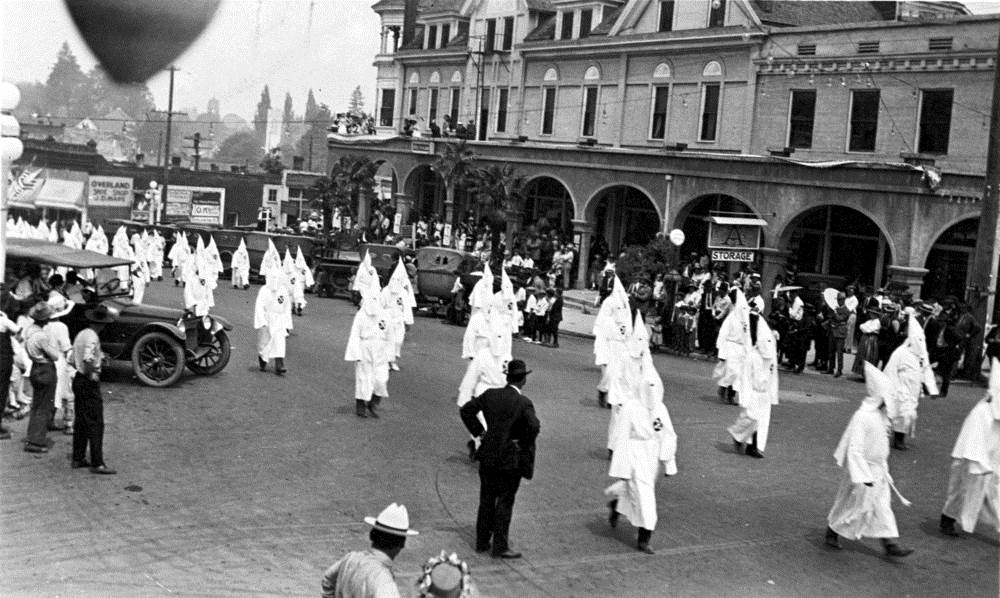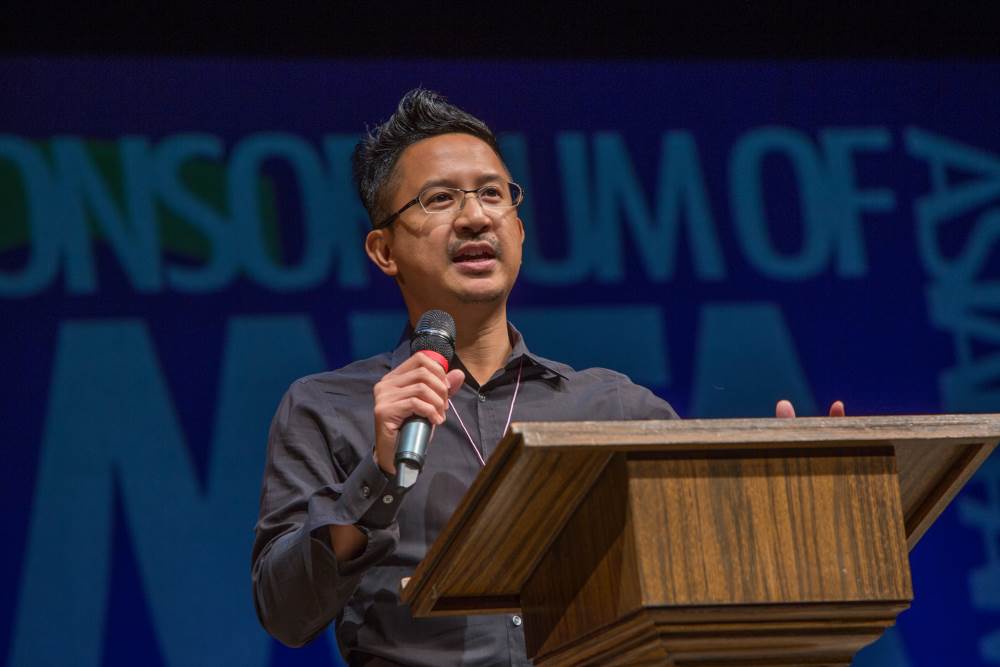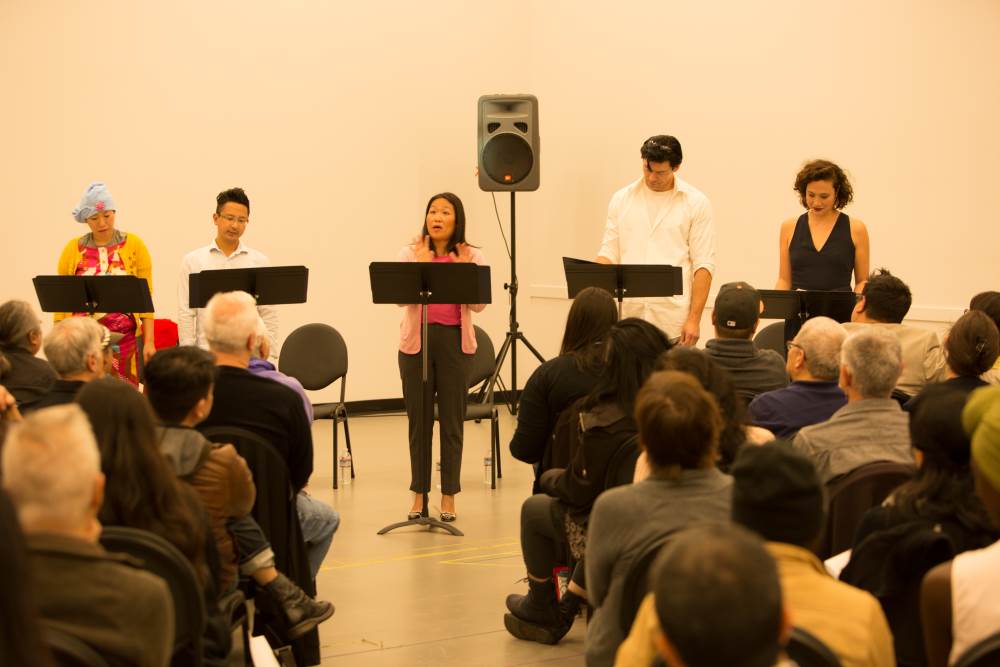ASHLAND, ORE.: On an October day in Oregon, a group of theatre artists were getting ready to cross the street. The pavement was damp with rain and the sun was peeking out from behind the clouds. The artists were on both sides of the street, about 100 bodies total. Then, three piercing beeps from a whistle rang out. Beep! Beep! Beep! All at once, those on the sidewalks flooded into the street. And stood there. It was an array of faces. Asian. White. Black. Some were carrying “Black Lives Matter” signs.
It lasted 30 seconds—a silent protest, and a reclamation.
In the 1920s, Oregon was home to around 35,000 members of the Ku Klux Klan. On the Oregon Encyclopedia entry on the subject, there is an image of a KKK march in Ashland, taken at the intersection of East Main Street and North Pioneer Street in 1923, directly in front of what are now the offices of the Oregon Shakespeare Festival (the festival was founded in 1935). This October’s silent protest was in direct response to that image. “We are replacing that KKK image with this picture, this multicultural picture!” shouted facilitator Leslie Ishii to the crowd afterward, as a rainbow formed, improbably but fortuitously, on the horizon.

It was the second day of the Consortium of Asian-American Theaters and Artists’ (CAATA) fifth biennial conference and festival, colloquially called ConFest. The event was held Oct. 1-9, and the theme was “Seismic Shifts: Leading Change in the American Theatre.” Hosted by Oregon Shakes, it gathered around 300 attendees for 7 days of large-group plenaries, small-group discussion sessions, five CAATA-produced full-length performances, and five new-play readings. There were also two days worth of pre-conference sessions centered around Beyond Orientalism, the latest diversity and inclusion effort from Theatre Communications Group (in partnership with organizations around the country).
Founded in 2003, CAATA began when six Asian-American artists and leaders of Asian-American theatres around the U.S. found themselves in the same room at a TCG conference. Mia Katigbak recalled the moment a few years ago when I asked her about CAATA’s formation. “Here we are, knowing of each other’s work but we had never been in a room together,” she said. “As we talked, we kind of thought, Boy, we should really think about getting together in something similar that was going on to that [TCG] convening.” Katigbak, an actor and the founder and artistic director of National Asian American Theatre Company in New York City, is now a CAATA board member (she also attended the 2016 ConFest but left before we could catch up).
The inaugural CAATA Conference, called “The Big Bang,” was held in 2006 in Los Angeles. Then in 2007, the inaugural performance festival was held, featuring a total of 30 productions over a two-week period in New York City. The conference and festival were combined into one big ConFest in 2011 in Los Angeles. The 2016 ConFest is considered the fifth conference and festival; that first 2006 conference and first 2007 festival are counted as one entity.
For CAATA board president Randy Reyes, who serves as artistic director of Mu Performing Arts in Minneapolis, while the conversations at every conference have included similar themes—appropriation, invisibility, lack of opportunity, the challenges of theatremaking—the scope has widened. “When we first got together, it was like, ‘Oh my gosh, it’s so great for us to be able to talk about this,’” he recalled of that 2006 conference. “Now it just seems like that choir is bigger, and other people have added to it that are not just Asian Americans. I think we now have allies within other communities of color and white allies who are wanting to be part of it and understand the importance of it.”
That solidarity was in full force on the intersection of Main and Pioneer. It was also clear from the 2016 festival host. OSF wasn’t just chosen for its high profile; the institution’s commitment to diversity also made it a good fit. The 2016 season, which began in January and ends this coming weekend, has featured 51 percent people of color on its stages, and also happened to feature two productions with predominantly Asian-American casts: A version of Shakespeare’s The Winter’s Tale, directed by Desdemona Chiang, and Vietgone by Qui Nguyen. In fact the latter was notable as the first OSF production to feature an all-Asian-American cast.
“The events of these 10 days is going to be on the very, very short list of things I’ve been most proud to have had happen when I was artistic director,” said artistic director Bill Rauch during the Wednesday morning plenary. He also made a promise: “I want to make a commitment right here and now to not ever produce a work at OSF that unthinkingly propagates the unfortunate and destructive tradition of yellowface.” Without naming them, he could have been referring to such OSF productions as Mary Zimmerman’s The White Snake or Ping Chong’s Throne of Blood, which featured some non-Asian performers in the roles of Chinese or Japanese characters, respectively.

Yellowface, according to Reyes, was a focus for this year’s ConFest, in response to recent instances of the practice around the country, the most high-profile ones being productions of The Mikado at New York Gilbert & Sullivan Players and of Lloyd Suh’s Jesus in India at Clarion University in Pennsylvania). But in responding to the latter controversy at Monday morning’s opening plenary, Suh expressed a familiar feeling: exhaustion.
“I really hate talking about yellowface,” he said, pointing out that ConFest is the third event on the theme he’s been invited to speak at this year—and he’s been invited to 10 more. That means, as he put it, that he spends a large amount of his time “dealing with other people’s shit,” being an activist rather than being a playwright. So Suh suggested another strategy to the room: Create great work and promote that work and the work of other Asian-American artists.
“The hill that I want to die on,” said Suh, “that I think is the most effective strategy for neutralizing yellowface is the advancement of the extraordinary community of Asian-American playwrights that are generating and developing work right now.” His statement was met with enthusiastic applause.
This forward-looking outlook struck a nerve with many ConFest participants, and came up in multiple sessions throughout the conference. While taking a break in the ConFest lounge, with its collection of plush couches, I asked conferencegoer Alison De La Cruz, who serves as the director of performing arts and community engagement at the Japanese American Cultural and Community Center in Los Angeles, about how best to increase the visibility of the work of Asian-Pacific Islanders in the American theatre.
“The best way to do that,” De La Cruz told me, “is for me to get in and do the best work that I can, and produce the best work that I can find, so that there is no question about excellence, there’s no question about availability of work, there’s no question about talent pool.” The onus isn’t all on organizations and artists of color, though; to producers at predominantly white institutions who use the purported scarcity of diverse talent as an excuse for their lack of diversity, De La Cruz countered, “No, it’s about your deficiency in not knowing us!”
I can second that. As someone who saw all of the productions and readings at ConFest (and who sees about three to four productions a week in New York City), producers and theatres around the country who don’t know this work are missing out. Whether it was an Indian-American woman having her own Eat, Pray, Love adventures in India (in Muthaland, written and performed by Minita Gandhi), a Chinese-American woman traveling to Africa to discover that she’s considered white in Uganda (The Wong Street Journal, written and performed by Kristina Wong), or a half-Asian woman spending the weekend with a rich white family (in a reading of Two Mile Hollow by Leah Nanako Winkler), all the works showcased at the ConFest painted a portrait of the Asian-American experience that was multifaceted, moving, and—the buzzword that producers love—relatable.
What I took from these shows is that there is no such thing as a quintessential Asian-American story. Yes, there are sometimes similar themes: cultural identity and the struggles to retain one’s heritage within American culture. But the journeys around those struggles are as varied as the people who write about them; fortunately, there is no one way to write an identity politics play.
Not that Asian-American-created work are just about identity. Some, like Five Mile Hollow, are about how to be an artist when you have a lower-income background, and others (like Eleven Reflections on September by Andrea Assaf) are about how the U.S.-led war on terror has affected the Middle East. Other plays, such as the reading of Picnic by Joned Suryatmoko, may happen to take place in a men’s bathroom in Bali but deal with the subjects of friendship and ambition.
Taken together in one large gulp at a festival, the ConFest shows told me that the state of Asian-American theatre is healthy, vibrant, and bursting with talent. Oh, and not getting produced enough beyond theatres of color. Case in point, Winkler’s hilarious yet heartfelt play earned a standing ovation in a crowd that was mixed with ConFest attendees and OSF subscribers. But it doesn’t have a producer attached. Roger Tang, executive producer of Pork Filled Productions in Seattle, tweeted this after the reading: “Two Mile Hollow by @leahnanako oughta be picked up by someone. Soon. It’s hilarious!!!” Hopefully someone will take the bait.

Showcasing the breadth of Asian-American theatre wasn’t the only goal of ConFest. The conference portions of the week were about trading tips for increasing Asian-American visibility, helping the community’s artists grow and advance in their careers, and finding productive responses to racial injustice. The titles of the gatherings were colorful: “There Will Be Awkwardness: A Conversation About Race,” “Building the Next Asian American Leaders,” and “In Case of Yellowface, Break Glass!”
Civil rights activist Karen Narasaki used her experience advocating for diversity in television, as then-chair of the Asian Pacific American Media Coalition, to give some concrete advice at Wednesday morning’s plenary speech. She credits that advocacy for the emergence of television showrunners of color such as Alan Yang and Mindy Kaling, and to the increase in performers of color on television. This progess wasn’t just about nurturing a talent pool, she said.
“For television diversity, we focused on building pipelines but also, importantly, to make sure that [artists] had a chance to get to know the people who’d actually give them the jobs,” Narasaki explained. “We worked to ensure that internships were paid so you didn’t need wealthy and supportive parents to get a break into the industry.” Narasaki was appointed in 2014 by President Obama to be a commissioner on the United States Commission on Civil Rights.
Money also came up during a session on Asian-American directors. “No conversation about equity should happen without a conversation about compensation,” said Eric Ting, the new artistic director at California Shakespeare Theater. “Compensation is one of the largest barriers. If we want to create a more diverse theatre, it’s not about the opportunities and offering them—that’s only 25 percent of the journey.” Instead, he said, diversity efforts should emphasize “cultural diversity, gender, but also class. We have to find a way to compensate artists and address the ticket price issue.”
Sometimes action happened right in the room. During the session “In Case of Yellowface, Break Glass!,” a number of artists shared Lloyd Suh’s lament: having to play activist instead of doing their art. In response, TCG’s associate director of equity, diversity, and inclusion, Elena Chang, created an email account on the spot: 1800yellowface@gmail.com, she said, is for those who are “tired and burnt out,” and want to simply report to her instances of racial insensitivity rather than engaging directly in the fight.
All told, Leslie Ishii, CAATA’s conference organizer and producer, considered the 2016 ConFest a resounding success.
“I think we met our goal in terms of galvanizing the community, helping work and partnership to come forth from that,” she said when I caught up with her in the days after. “I heard about folks wanting to partner, casting people who are starting to get new ideas for utilizing the actors they’ve seen, and playwrights who were really happy to see the new work.”
Of course, all the good will and solidarity in the world isn’t going to erase racial offenses overnight. It was during ConFest that FOX News’ “The O’Reilly Factor” aired its infamous segment about in New York City’s Chinatown, which mocked Chinese Americans as ignorant and meek. And the day after I returned from Oregon, Michael Luo of The New York Times wrote an article with the self-explanatory title, “An Open Letter to the Woman Who Told My Family to Go Back to China.” Triggering moments still abound.
But the Asian-American community has become better at rallying around controversy and demanding change. Case in point: “Mail Order Family,” a television show about a white family whose matriarch is a mail-order bride from the Philippines, got a pilot order from NBC in September; following outcry from the community, NBC cancelled the order. And on Nov. 3, New York Gilbert & Sullivan Players (NYGASP) will host a public forum entitled “The Mikado in the 21st Century,” in response to the protests last year around its planned production. (NYGASP will unveil its “brand new” production of The Mikado on Dec. 28.)
“I think that the Asian-American community is more vocal,” said Reyes. “With everything that’s happening, with Beyond Orientalism, the representation on Broadway, and then what happened at the Oscars, people are not just quiet about this. There’s a big push on social media to bring awareness to this invisibility and these disparities. So that’s really exciting. I feel like we’re louder than before and more people are willing to speak up.”
While online conversations have been productive, there’s also value in creating a shared physical space, and that is what ConFest brings to the table. For many attendees I talked to, and for myself, ConFest provided nourishment, and new energy for the fight ahead. The day after I returned from OSF, I received a Facebook notification from Lily Tung Crystal, artistic director of Ferocious Lotus in San Francisco; she had tagged me in her Facebook status. It read, in part: “I’m having serious withdrawal from #CAATAOSF. What a profound week of friendship, art, and activism… I didn’t want to leave this safe theatre cocoon, yet came home with such hope. But today, real world buzzkill—Angry Asian Man’s news of Disney’s whitewashed Mulan and Michael Luo’s article about anti-[Asian-American] racist attacks in NYC. And we move forward and do our work and our art. #CAATAOSF colleagues, you’re still in my heart.
“Trying to hold on to the light… Trying to hold on to the light…”
Same.


